

Biodiversidad Mexicana. Biodiversidad Mexicana. Los mamíferos (Clase: Mammalia) es el grupo más conocido de los vertebrados.
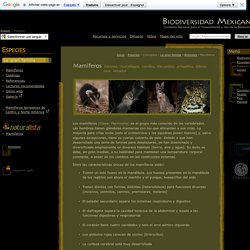
Las hembras tienen glándulas mamarias con las que alimentan a sus crías. La mayoría pare crías vivas (solo el ornitorrinco y los equidnas ponen huevos) y, salvo algunas excepciones, tiene su cuerpo cubierto de pelo. Debido a que han desarrollado una serie de formas para desplazarse, se han diseminado y diversificado ampliamente en diversos hábitats (tierra, aire y agua). Su éxito se debe, en gran medida, a su habilidad para mantener una temperatura corporal constante, a pesar de los cambios en las condiciones externas. Entre las características únicas de los mamíferos están: Tienen un solo hueso en la mandíbula. 10 Recently Extinct Animals. Animals Mankind has the honor of quite possibly being the most destructive force to ever hit mother nature.

This list looks at some of the more recent, probably lesser known extinctions that humans have lent a helping hand to. Whether by over hunting or over population, driving a species to extinction is nothing to be proud of and it’s certainly not slowing down. Here’s Every Single Animal That Became Extinct In The Last 100 Years (PHOTOS) Update 6/22/2015: On Friday, a study published by experts from Stanford, Princeton and the University of California-Berkeley declared the world’s vertebrates are going extinct 114 times faster than the natural rate of extinction, according to the Huffington Post.
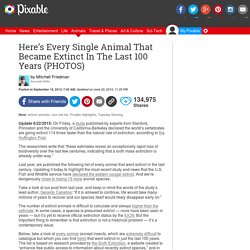
The researchers write that “these estimates reveal an exceptionally rapid loss of biodiversity over the last few centuries, indicating that a sixth mass extinction is already under way.” Last year, we published the following list of every animal that went extinct in the last century. Updating it today to highlight the most recent study and news that the U.S. Fish and Wildlife service have declared the eastern cougar extinct. And we’re dangerously close to losing 13 more animal species. 17 Animals That Became Extinct In Our Lifetime. The Sixth Extinction - Globally Extinct: Mammals.
In 2008, the most comprehensive assessment of the world’s mammals has confirmed an extinction crisis, with almost one in four at risk of disappearing forever, according to the IUCN Red List of Threatened Species (IUCN 2008).
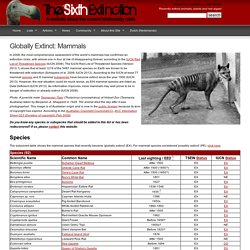
The IUCN Red List of Threatened Species (Version 2013.1) shows that at least 1219 of the 5487 mammal species on Earth are known to be threatened with extinction (Schippers et al. 2008; IUCN 2013). According to the IUCN at least 77 mammal species and 8 mammal subspecies have become extinct since the year 1500 (IUCN 2013). However, the real situation could be much worse, as 834 mammal species are listed as Data Deficient (IUCN 2013).
As information improves, more mammals may well prove to be in danger of extinction or already extinct (IUCN 2008). Photo: A juvenile male Tasmanian Tiger (Thylacinus cynocephalus) at Hobart Zoo (Tasmania, Australia) taken by Benjamin A. Do you know any species or subspecies that should be added to this list or has been rediscovered? Baiji. The baiji (Chinese: 白鱀豚; pinyin: báijìtún , Lipotes vexillifer, Lipotes meaning "left behind", vexillifer "flag bearer") was a freshwater dolphin found only in the Yangtze River in China.
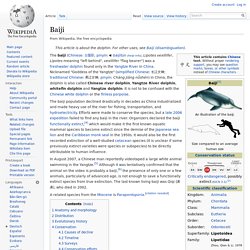
Nicknamed "Goddess of the Yangtze" (simplified Chinese: 长江女神; traditional Chinese: 長江女神; pinyin: Cháng Jiāng nǚshén) in China, the dolphin is also called Chinese river dolphin, Yangtze River dolphin, whitefin dolphin and Yangtze dolphin. It is not to be confused with the Chinese white dolphin or the finless porpoise. The baiji population declined drastically in decades as China industrialized and made heavy use of the river for fishing, transportation, and hydroelectricity.
Quaternary extinction event. The Quaternary period saw the extinctions of numerous predominantly larger, especially megafaunal, species, many of which occurred during the transition from the Pleistocene to the Holocene epoch.
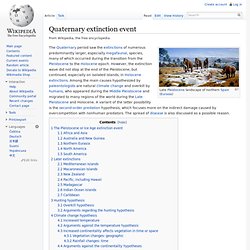
However, the extinction wave did not stop at the end of the Pleistocene, but continued, especially on isolated islands, in Holocene extinctions. Among the main causes hypothesized by paleontologists are natural climate change and overkill by humans, who appeared during the Middle Pleistocene and migrated to many regions of the world during the Late Pleistocene and Holocene. A variant of the latter possibility is the second-order predation hypothesis, which focuses more on the indirect damage caused by overcompetition with nonhuman predators. The spread of disease is also discussed as a possible reason. Lascaux. Conoce el secreto de las cuevas de Lascaux con AstroFácil.
La cueva de Lascaux es una de las representaciones más importantes de la cultura auriñaciense.

Es cierto que su contenido no está tan desarrollado como ya cuevas de Altamira, que representan el punto más importante de la pintura magdaleniense. Pero su importancia radica en el excepcional estado de las pinturas de la última época auriñaciense. En la cueva se han encontrado representaciones aún más antiguas y otras más modernas, que se podrían catalogar como pre-magdalinenses. Parece que estas cavernas eran utilizadas como santuarios por distintas generaciones. En la cueva de Lascaux vemos que los artistas aprovecharon el relieve de las paredes para dar volumen a sus representaciones. Nos hemos centrado en la cueva de Lascaux y no en Altamira porque hay dibujos que parecen representar elementos de la bóveda celeste. Ten en cuenta que estamos hablando de unas pinturas que tienen entre 14.000 y 15.000 años de antigüedad. El toro de Lascaux tiene un grupo de estrellas sobre él. Humans Have Caused 322 Animal Extinctions in the Past 500 Years.
Category:Species made extinct by human activities. Humans Caused 322 Animal Extinctions in Past 500 Years. Our species caused 322 animal extinctions over the past 500 years, with two-thirds of those occurring in the last two centuries, according to a paper published in a special issue of the journal Science this week.
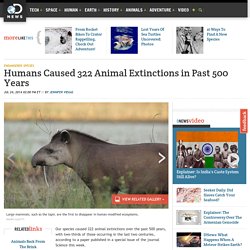
Many animals are threatened with human-caused extinction now, with researchers expressing particular concern over amphibian and invertebrate (creatures without a backbone) losses. Numbers of the latter group have nearly halved as our population doubled in size over the past 35 years. Ecologists, zoologists and other scientists believe that, without urgent steps to stem the losses, we are facing global scale tipping points from which we may never look back or recover. Could These 10 Animals Be Resurrected? Dirzo and his colleagues call for "decreasing the per capita human footprint," by developing and implementing carbon-neutral technologies, producing food and goods more efficiently, consuming less and wasting less.
List of Mammals Extinct after 1500 AD. Great auk. The great auk (Pinguinus impennis) was a flightless bird of the alcid family that became extinct in the mid-19th century.
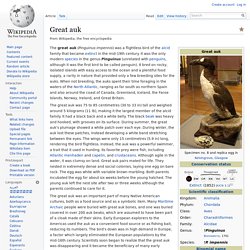
It was the only modern species in the genus Pinguinus (unrelated with penguins, although it was the first bird to be called penguin). It bred on rocky, isolated islands with easy access to the ocean and a plentiful food supply, a rarity in nature that provided only a few breeding sites for the auks. When not breeding, the auks spent their time foraging in the waters of the North Atlantic, ranging as far south as northern Spain and also around the coast of Canada, Greenland, Iceland, the Faroe Islands, Norway, Ireland, and Great Britain. The great auk was 75 to 85 centimetres (30 to 33 in) tall and weighed around 5 kilograms (11 lb), making it the largest member of the alcid family. It had a black back and a white belly.
The great auk was an important part of many Native American cultures, both as a food source and as a symbolic item. Taxonomy and evolution[edit] The IUCN Red List of Threatened Species. List of recently extinct mammals. A large number of prehistoric mammals are extinct, such as Megafauna.
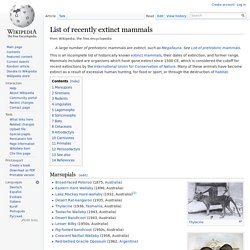
See List of prehistoric mammals. Kennis & Kennis Reconstructions. Extinctions in Near Time - R. D. E. MacPhee. "Near time" -an interval that spans the last 100,000 years or so of earth history-qualifies as a remarkable period for many reasons. From an anthropocentric point of view, the out standing feature of near time is the fact that the evolution, cultural diversification, and glob al spread of Homo sapiens have all occurred within it. From a wider biological perspective, however, the hallmark of near time is better conceived of as being one of enduring, repeat ed loss. The point is important. Despite the sense of uniqueness implicit in phrases like "the biodiversity crisis," meant to convey the notion that the present bout of extinctions is by far the worst endured in recent times, substantial losses have occurred throughout near time.
Species Extinction Time Line. The animals represented below are only a small selection of the species that have gone extinct since 1600. But they give a sense of the enormity of what we've lost—and what, with the dawn of species-revival science, we may stand to regain. Source: IUCN 2010. IUCN Red List of Threatened Species. Version 2010.1. Downloaded on 21 January 2013. New Video: Recipe for Resurrection Video: Should We Bring Back Extinct Species? On Friday, March 15, at our Washington, D.C., headquarters, National Geographic hosted TEDxDeExtinction, a daylong conference on species-revival science and ethics convened by Revive & Restore. Advertisement More in National Geographic See exclusive photos and in-depth reporting on de-extinction in April's National Geographic—available as a digital edition now and on print newsstands later this month.
Global late Quaternary megafauna extinctions linked to humans, not climate change. Abstract The late Quaternary megafauna extinction was a severe global-scale event. Two factors, climate change and modern humans, have received broad support as the primary drivers, but their absolute and relative importance remains controversial. Especies endémicas de México. Endangered, Vulnerable, and Threatened Animals. ¿Qué son las especies?